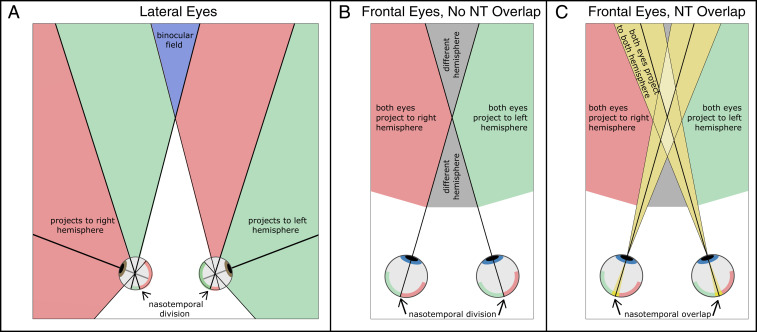Fig. 1.
Projections to hemispheres in lateral- and frontal-eyed mammals. (A) Top view of lateral-eyed animal. Nasal retina and temporal retina in the left eye are represented by pink and green, respectively, and the opposite for the right eye. Pink regions in front of the animal represent points in the visual scene that produce signals that travel to the right hemisphere. Green regions represent points that produce signals to the left hemisphere. The blue region represents the binocular visual field where points stimulate both retinas. (B) Top view of a frontal-eyed mammal with no crossed–uncrossed nasotemporal (NT) overlap in the decussation pattern. The left and right halves of the retinas are represented by green and pink, respectively. Green and pink regions in front of the animal represent scene points that produce signals from both eyes to the left and right hemispheres, respectively. Gray regions represent scene points that would send signals from the two eyes to different hemispheres (i.e., regions for which there is no binocular integration through direct paths from the retinas to cortex). (C) Top view of frontal-eyed mammal with crossed–uncrossed overlap in the decussation pattern. Green and pink regions in the retina again represent regions for which both eyes project to one hemisphere. Yellow regions in the retinas represent the crossed–uncrossed overlap: the parts of the retinas that project to both hemispheres. Yellow regions in front represent scene points that produce signals to both hemispheres due to the overlapping projections. Light yellow represents regions where stimulation occurs in either the nasal retinas of both eyes or the temporal retinas of both eyes. Due to the crossed–uncrossed overlap, signals from both eyes would be sent to both hemispheres. Gray regions represent points in the scene that send signals from the two eyes to different hemispheres. They are much smaller than when there is no crossed–uncrossed overlap.

